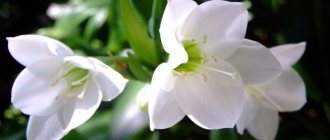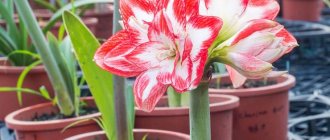Fighting diseases and pests of indoor eucharis plants with photos
It is worth noting that the tropical plant is quite hardy and has strong immunity, which protects it from diseases and all kinds of pests.
However, eucharis reacts sharply to improper care with the appearance of problems: it can be affected by diseases or pests. Excessively dry air, proximity to heating devices, and lack of moisture can lead to the appearance of the following pests:
- Aphid.
- Shield.
- Spider mite.
- Thrips.
If any of the listed parasites are detected, you must first wash the leaves with soapy water. After this, the plant is treated with systemic insecticides, for example, Actellik. The product should be used twice with an interval of 7-10 days, following the recommendations on the package.
Another pest, the bulb mite, appears as a result of systematic waterlogging of the soil. You can find it by looking at the bases of the leaves at the edge of the soil and digging slightly deeper. These small white parasites damage the plant by eating the bulbs and stems from the inside, preventing them from developing. The control measure is to treat the plant with acaricides (Akarin) and completely replace the soil.
To preserve the plant, experts recommend regularly inspecting it for the following damage: spots on leaves, cuttings, yellowing of leaves, loss of elasticity, etc.
Reproduction of Eucharis
Cissus flower.
Description, features, types and care of cissus Eucharis can be propagated by transplantation, using grown bulbs from a pot. This method is very convenient, new bulbs take root well and grow quickly. They are called children. Several small ones are separated from the mother bulb and planted in separate pots with 3-5 bulbs in each. All sections are sprinkled with crushed charcoal or activated carbon. Planting is carried out to a depth of up to 5 cm. Group planting of bulbs is done so that the plant blooms faster
After planting, in the first few weeks, carefully and little by little water the bulbs in the pots, and after a month you can see the first leaves of the new plant. Young eucharis are cared for in the same way as adult plants
If you follow all the rules for growing, the Amazon lily will delight you more than once a year with its beautiful snow-white flowers and bright, juicy foliage. A simple method of propagation allows you to easily propagate plants and replenish your flower garden with new specimens.
Bulb selection
Adult plants offered in flower shops are grown in a greenhouse and can adapt to home conditions for a long time.
Sometimes flower growers buy baby eucharis bulbs. You can find them for sale on flower forums, exhibitions or on Avito, from those who breed Amazonian lilies.
When choosing a bulb, pay attention to its condition. She must be:
- dense to the touch, without soft, rotten areas;
- covered with a light brown shell;
- intact, without dents or other damage.
Growing and care
Fatsia flower: home care and methods of propagation
At home, it is better to place eucharis on eastern or western windows, since the plant does not tolerate midday sun.
Eucharis is a heat-loving plant, so when you take it out to the balcony in the summer, do not forget to bring it indoors with the onset of cold August nights.
In winter, the optimal temperature is +16-20 degrees. If the room temperature is too warm or cold, the plant can only produce small, frail flowers.
If you provide the plant with proper care, the eucharis will delight you with flowers at the end of summer, and after a few months the plant will bloom again.
Eucharis prefers loose, nutritious soil.
For successful cultivation, the plant must be properly watered. Eucharis likes rare but abundant watering: it is enough to water it 2-3 times a month, trying to ensure that the earthen ball absorbs as much water as possible, but before summer and autumn flowering the earthen ball must be dried: for this, watering is reduced, but not allowed wilting of leaves.
In general, eucharis loves cleanliness, so it is washed in a warm shower, after which the pot is left in the bathroom, waiting until the excess water drains.
In summer, the plant is regularly sprayed.
If not properly cared for, the plant suffers from being attacked by spider mites, whiteflies, and scale insects. But most often the pests that can be found on the plant are mealybugs and scale insects. Then the insect is either removed with a stick, or the petioles and leaves are washed with tobacco infusion, adding green soap to it.
But by inspecting the plant regularly, you can avoid the appearance of pests.
Eucharis transplant
Many people believe that eucharis does not tolerate transplantation well and does not bloom for a long time after it.
But, following all the rules of transplantation, you can get a peduncle of a young plant in the first year, and the mother plant can also give a peduncle.
When is the best time to do a transplant? Usually it is produced once every 3-4 years. It is better to do this during the rest period. It is advisable to preserve the earthen ball during transplantation. The main feature of transplanting eucharis is that the children should not be separated from the mother plant unnecessarily, since if they are planted one at a time, they will not be able to bloom for a long time.
For planting, take shallow but wide pots filled with a nutrient mixture into which the bulbs are planted. The optimal depth for planting is 4-5 cm. The transplanted plant is rarely watered. Feeding can begin 2 weeks after transplantation.
Reproduction
Eucharis reproduces by baby bulbs.
If your bulb is ready for planting, then it is better to plant it in March. When planting a bulb, keep in mind that the mother plant produces daughter bulbs, so it is better to take a wide pot for planting. To root the plant, you can use bottom heating: this will avoid the process of rotting.
During the period of plant development, the substrate should be moderately moist: for this, watering should be done once every 3-4 days, and it is useful to spray the leaves.
As soon as the tops of new leaves appear on the bulb (usually this happens after 1-1.5 months), once every two weeks it is necessary to fertilize with mineral and organic fertilizers.
Since eucharis is quite thermophilic, the temperature during the growth period should not fall below 18 degrees. When temperatures change, leaves may drop and bulbs may freeze.
The appearance of daughter bulbs indicates that the eucharis is ready to flower.
The lack of flowering indicates that the plant was not provided with a sufficient period of rest.
Tips for flower growers
In order to provide the plant with air access to the roots and to allow water to drain freely after watering, widen the hole in the flower pot.
It is not worth wiping dust from the leaves with a wet cloth, as the resulting dirt clogs the stomata of the plant, thereby making it difficult for the euaris to breathe. It is better to first remove the dust with a soft, dry cloth, and then wipe with a damp cloth.
To prevent brownish spots from forming on the plant during flowering, stop spraying, reduce watering after flowering, and stop feeding.
In order for the plant to please you with its appearance, you need to prevent the shedding of old leaves and the growth of new ones.
In summer, the plant can be taken out into the fresh air.
general description
The Amazon lily flower of the Amaryllis family has large, 11-12 centimeters in diameter, snow-white flowers that do not resemble lilies at all.
Located 5-6 on one peduncle (of which an adult specimen can throw out several), drooping, in appearance they are closer to large daffodils with a small greenish crown framed by an inlay of stamens, and their aroma is also similar to the aroma of daffodils - subtle, delicate, but strong enough.
Translated from ancient Greek, the name Eucharis is translated as “most beautiful,” and one cannot but admit that he deserves this name: porcelain bells of large flowers on long peduncles reaching up to 60-70 centimeters will not leave indifferent any connoisseur of the strict, sophisticated beauty characteristic of for many members of his family.
Eucharis blooms twice a year: in spring and late autumn, and one inflorescence lasts quite a long time, but even without flower stalks the plant looks attractive - its large, dark green leathery leaves on long petioles are quite decorative in themselves. Their length is 30-35 centimeters, and their width is greater than the width of the average human palm.
Unlike many other bulbous plants, even during the dormant period between flowering, the Amazon lily does not shed all its foliage and does not easily tolerate the loss of its carefully grown greenery, so in no case should you force it to sleep by cutting off the leaves or moving the plant into the dark.
ATTENTION! You can control periods of growth and dormancy by controlling watering - this will cause flowering up to three times a year.
As you can guess from its name, the Eucharis flower came to Europe from the New World. At the beginning of the 19th century, it began to gradually gain a place in greenhouses and winter gardens, and then came to apartments and houses. Due to the fact that it is easy to propagate using baby bulbs, anyone can now become a happy owner of this majestic and delicate plant.
IMPORTANT! Eucharis is a family plant, it is difficult to transplant and divide, it blooms much better when it lives in close company, so you should not divide the bush unless absolutely necessary and expect immediate flowering from a lonely onion: first it needs to grow a lot of greenery and surround itself with a retinue of children.
Since the flower’s foliage is heavy and the root system is superficial, it is best to plant it in a wide, shallow ceramic pot. This way Eucharis will not fall to one side under its own weight and will be able to grow for a long time in a habitable container.
PAY ATTENTION to other types of lilies that will also delight you with their impeccable appearance: Asiatic Lily, White Lily, Oriental Lily.
What promotes flowering
Alocasia - home care, description of Polly and Amazon varieties
The flowering of this amazing tropical flower, as previously mentioned, will be facilitated by specific care. And if you plan to wait for white flowers at home, then it is worth familiarizing yourself with the needs of the crop in order to create the most optimal growing conditions for it.
Place for a flower
Initially, you need to find a suitable place for eucharis. Like many indoor plants, this flower is light-loving. However, the sun's rays, especially at midday, falling directly on the foliage can leave burns on it. Window sills of western and eastern windows are ideal.
Temperature conditions
This flower is quite thermophilic. Therefore, depending on the stage of plant development, the temperature should be:
- +18 degrees and above – during active periods of growth and flowering (spring and summer);
- from +13 to +16 degrees – in winter.
A sharp change in temperature will affect the size of the flowers - they will be much smaller. Although the plant usually blooms with rather large flowers (see photo).
Watering
Another reason why eucharis does not bloom at home is improper watering.
Indeed, for most bulbous plants, which include the Amazon lily, care in terms of watering should be done with special attention
Eucharis flowers should be watered sparingly. It is necessary to water in such a way as to prevent either over-moistening or over-drying of the substrate in the pot. The top layer of soil can be used as a signal that the plant needs watering.
For irrigation, it is recommended to use soft, settled water. Melt and rain water are also excellent.
As for the dormant stage, watering should be reduced at this time. As a rule, this period lasts about a month and begins immediately after the last inflorescence fades.
For a flower, the dormant stage occurs in semi-dry soil conditions. That is, throughout the entire period, the upper half of the soil in the pot should remain dry. You need to water lightly, avoiding excess moisture in the soil.
Sometimes Eucharis leaves may turn yellow. If only 1-2 leaves turn yellow, don't worry. But if almost all the foliage simultaneously begins to acquire a yellowish tint, wither and dry out, as shown in the photo, watering should be limited. Often, such signs appear when there is excessive watering, sometimes when the soil dries out and during sudden changes in temperature.
Humidity
In this regard, caring for eucharis grown at home is simpler. The flower only needs spraying during the growing season. However, it is necessary to carry out this procedure very carefully to prevent water from getting on the white flowers. Otherwise, they will be affected by spotting, which will significantly reduce the decorative value of the plant.
Transplants
At home, beautiful eucharis are transplanted extremely rarely. These flowers are very sensitive to this kind of procedure and do not tolerate disturbances in growing conditions. Including changes in the earthen coma.
It is recommended to transplant this representative of indoor flowers once every 3-4 years. As a rule, during this period of time a transplant will already become necessary. Since in 3-4 years the pot is already completely filled with young eucharis children, it becomes increasingly difficult for an adult plant to feed.
It is recommended to transplant the plant into a new container in March. The new pot must have drainage holes. The bottom of this vessel should be lined with a fairly thick layer of drainage, and soil should be poured on top. For eucharis, a loose substrate with a neutral composition and good permeability is suitable. At home, you can make your own growing mixture from:
- leaf soil;
- sand;
- compost;
- loam.
It is necessary to plant the bulb of an adult plant without deepening its base deep into the soil, as shown in the photo.
Reproduction
You also need to decide what you are going to do with the plant children (pictured). When replanting, you can plant them in separate pots, thus multiplying the flower. But if you want to achieve lush flowering of an adult plant, then you should transplant it into a new pot along with the children. The mother plant will be pleased with abundant flowering if the pot is slightly cramped and properly cared for.
Feeding
Another answer to the question: “Why doesn’t eucharis bloom?” is the lack of fertilizing
It is especially worth paying attention to such procedures during the growing season, and feeding them with complex organic and mineral fertilizers every 2 weeks. Feeding should be stopped after the plant blooms for about 3-4 weeks.
When it blooms
Depending on maintenance conditions, flowering may occur in spring, summer or autumn . Often, with proper care, eucharis blooms again during the season.
Well-developed, mature plants are capable of producing from 5 to 8 peduncles each and there will be several flowers at the top of each peduncle.
The first and most abundant flowering will occur in the autumn months or early winter, with a second wave appearing in late spring and early summer.
Each flower is able to maintain its attractiveness for 1 week , and each peduncle fades in about 3 weeks.
Treatment of diseases
At the slightest deviation, the normal functioning of eucharis is disrupted - in the photo you can see the main diseases associated with an imbalance of watering and spraying.
First of all, the inflorescences are destroyed - the plant does not bloom for a long period - up to a year. Then the diseases spread to the root system, which dries out or, conversely, rots. At the same time, the leaves turn yellow and quickly fall off, normal reproduction becomes impossible, the number of shoots decreases, and after a certain time the eucharis dies.
Therefore, in order to get a beautiful flower at home, which can be seen in the photo, it will need very high-quality care.
You will need to frequently inspect the leaves and root system, identifying diseases in the early stages, and regularly replant and propagate in order to prevent depletion of the Amazon lily.
Of course, caring for it will take a lot of time and effort, but the result will be worth it in any case - after all, you will not be able to see such extraordinary delicate beauty anywhere else.
Choosing the right place
If you don't have a lot of direct sunlight in your home, then you can safely choose eucharis. Care at home (reviews confirm this) is quite simple. The plant is not too demanding. However, it is better to immediately choose the right place for the Amazon lily. Firstly, eucharis is a fairly large plant and will require a lot of space, so it is often grown in floor flowerpots. Secondly, this flower grows mainly in the lower tier of the tropical forest, the light reaches it, but for the most part it is diffused. Direct sunlight on Amazon lilies is contraindicated; they will simply burn the leaves and flowers. The most optimal and favorable option is bright, diffused sunlight. However, eucharis still tolerates slight shading and will grow well even opposite a north window.
The most optimal temperature regime during flowering and active growing season is from 24 to 28 °C. In winter, the rates drop. After flowering ends, the so-called dormant period begins. It is not as clearly defined as, for example, in succulents or cacti, but it still occurs. At this time, you must avoid sudden changes in temperature and maintain it within 17-18 °C, but not lower than 7-8 °C, otherwise you will destroy the eucharis. Home care (rest period) described above should be carried out if you want abundant and long-lasting flowering. If the plant does not rest, then over time (at best) it shreds. Flowering will be minimal.
Amazonian lily eucharis. Home care
Eucharis (or Eucharis - Eucharis) is translated from Greek as “most pleasant”, “graceful”. The name more than matches the appearance of the flower, which many call the Amazon lily.
A lovely bulbous plant with a snow-white umbrella of large and fragrant flowers, very similar in appearance to daffodils - this is eucharis. Home care is not too difficult. It blooms for the first time in October and until mid-winter. The second time - in the spring. In March and August, when the eucharis is resting, it is usually replanted, separating the children from the bulb. The newly planted onion should be stored in a warm place and watered moderately until it germinates.
Types of Eucharis
The large-flowered eucharis - Eucharis grandiflora - is magnificent - from three to six simply huge flowers on a peduncle more than half a meter high, blooming twice a year. The pride of the amaryllis family. Ten species of this plant are cultivated, the large-flowered one being the most common. Eucharis candida (white eucharis) is very good, as well as Eucharis mastersii (masterza eucharis), Eucharis subdentata (toothless eucharis), Eucharis sanderi (sandera eucharis) - multi-flowered. This is how different eucharis is. You can’t take your eyes off the photo, but even the most successful one cannot fully convey its charm.
Origin
These beautiful flowers were born in the tropics of South America. The high humidity of the air in the forests of Colombia and especially in the equatorial Amazon region - these are the climatic features that eucharis expects from our apartments. Home care will ensure flowering. There were cases when, in hot and humid summers, this Amazonian lily bloomed for the third time in a year.
Peculiarities
Year-round decorativeness is the main advantage that eucharis fully possesses. Caring for it at home helps it not to shed its beautiful shiny leaves for the winter, huge, slightly wrinkled, with beautifully protruding veins. It may lose a leaf or two during winter sleep, but this, firstly, is imperceptible among the dark green abundance, and secondly, it is quite natural. It’s bad for it if you water it too much, then the leaf fall is total. When the eucharis wakes up, new leaves are quickly added to the existing ones: at first they stick out in all directions like a hedgehog, rolled into tubes, and gradually unfurl, this is a very beautiful and touching sight.
Eucharis - home care
Some gardeners complain: eucharis does not bloom! But in order for it to bloom abundantly and on time, so that rot does not occur on the roots and bulbs, the plant must be watered correctly. You can also advise novice gardeners to always check for a drainage hole at the bottom of the pot. Without it, not only eucharis, but also chlorophytum will not survive.
Throughout the entire period of growth and flowering, the Amazon lily should be watered sparingly, like other bulbous plants. Avoid overmoistening. Between waterings, be sure to allow the soil to dry out significantly; wet soil should not be watered under any circumstances. Eucharis leaves are so huge, they quickly gather dust, and therefore love to be washed in the shower. Then you can water the whole plant. The main thing is that water does not get on the flowers - they will turn yellow. And eucharis does not bloom because the pot is too large. Almost the entire surface of the earthen coma should be filled with children. Therefore, it is not replanted as often as other indoor plants. Once every three years. These are the two main mistakes that eucharis shows us with its non-flowering. Care at home strictly requires only two things: proper watering and correct planting of the bulb! It is not hard. And in favorable conditions, eucharis blooms for a long time, often and fragrantly!
fb.ru
Description of the plant
This plant came to us from the eastern slopes of the South American Andes, from where the Amazon begins its course. Hence another name for the flower – Amazonian lily. The plant came to Europe relatively recently, no more than 200 years ago, but it immediately found a huge number of connoisseurs.
Eucharis amazonica blooming
By some strange coincidence, eucharis acquired the fame of a mysterious, one might say, fateful flower. It appears in many signs and superstitions. Most of them involve women; sometimes this plant is also called a women's amulet.
Nowadays, far from mystical sacraments, botanists recommend eucharis as a means of purifying the air from harmful insects; However, you should not be zealous - the alkaloid lycorine contained in the plant is unsafe for humans in large doses.
From a botanical point of view, Eucharis belongs to the Amaryllis family, which means that it is not a lily, but an ordinary daffodil. This plant is bulbous, which means that it is not only capable of simple vegetative propagation, but is also rarely found in a single specimen. Eucharis bulbs have a dormant period characteristic of many amaryllis; although in some species there is only a slight decrease in plant activity (growth rate, formation of new leaves, etc.)
Eucharis flowers have a relatively large size - their diameter is about 12 cm. There are from 3 to 6 flowers on one peduncle. The peduncle itself can be up to 80 cm tall.
The leaves of the plant are dark green, often glossy, about 30 cm long and 12 to 15 cm wide. The petioles of the leaves are relatively long - sometimes their length is equal to the length of the leaf. Young leaves look like a twisted tube. Even during the dormant period, the leaves never completely fall off.
Flowering part of Eucharis close-up
Each bulb can produce 3-5 arrows, of which a minimum of 2 and a maximum of 5 peduncles will develop. Thus, the number of flowers from one bulb can reach from 6 to 20-30 pieces! To some extent, this is a record for flowers of this diameter obtained from one plant.
Eucharis flowering time is approximately 20 days, of which the flower itself retains its freshness for about 1 week. During this week, the aroma of blooming eucharis will fill the entire apartment, even one with a large area. Taking into account the fact that flowers have some delay in the moment of opening, the time of continuous flowering of eucharis without loss of freshness of the flowering parts will be about a month.
Eucharis with simultaneous flowering of all flowers on a peduncle
But that’s not all: eucharis, like many bulbous plants, can bloom twice per season. Of course, you will have to try to do this, in addition, after this it will need some rest after the second flowering. The approximate flowering time of eucharis is two months: April or October.
Flowering ends with the formation of fruits, which in Eucharis have the form of a triangular capsule containing small seeds. There are 20 species of Eucharis, about half of which were found in the wild relatively recently. There is a practice of interspecific crossing to obtain plant hybrids. Currently, there are about 50 hybrids of Eucharis and other amaryllis.
The plant has increased resistance to many pests. The reason for this is lycorine contained in its stems, bulbs and leaves. This alkaloid is found in many amaryllis plants and serves to protect the flowers; in addition, it promotes the synthesis of vitamin C in the bulbs.
For humans, this alkaloid can be dangerous because it affects the regulation of bronchial secretion. In large doses it can cause allergies and vomiting
When working with the plant, in particular when dividing the bulbs and removing diseased parts, it is recommended to be careful
Eucharis home care and photos
This perennial flower from Colombia, South America, with shiny, waxy leaves, belongs to the Amaryllidaceae family (which includes daffodils!). It is sometimes called the Amazon lily or Eucharist. "Eucharist" means "elegant" in Latin and "charm" in Greek. It grows to approximately 45 cm.
The flower can grow on both the light and dark sides of the windowsill. But you shouldn’t keep the plants in the shade all the time. If the window sills are large, then the pots are placed on them
It is important to remember that direct rays of the sun are contraindicated for the flower, because they will destroy the plant; the best position for it is partial shade
We also recommend that you familiarize yourself with the section: Crassula flower - care at home.
Temperature
The required temperature for eucharis is approximate, it should be up to 22 C. In winter, it will also feel comfortable at a temperature of +15-18 o C, but make sure that there are no sudden changes and drafts.
How to water and spray eucharis?
This plant needs infrequent watering, because if it is flooded, it will be quite difficult to save it. It is necessary to monitor the condition of the soil; if it completely begins to dry out, then water it. But you can’t flood the soil, because the bulb will rot. Holes must be made in the pot so that water can leave the container, otherwise the roots will simply rot and the flower cannot be saved. The requirement for watering changes throughout the year: more frequent in the spring-summer period, and in winter much less often, only when the earthen ball dries out.
In the room he needs to create the conditions in which he would grow up in nature; it is because of this that the air humidity must be very high. Spraying is necessary constantly, even more often in the summer. Sometimes the plant needs to wipe the leaves with a damp cloth. Stop spraying as soon as the flower stalk begins to appear.
The flower remains in the dormant stage for a month; this is a very important period. Because it accumulates strength for future growth. As soon as the flowers have faded, the dried flower stalks are removed. When the dormant stage begins and new shoots appear, the plant should be watered as before.
Eucharis: fertilizer
It is advisable to fertilize the flower in the summer. The fertilizing should not contain high levels of nitrogen. As soon as the dormant period begins, fertilizing is stopped immediately.
Eucharis: transplant and care
It is in the dormant stage that it is advisable to replant the flower, but you should know that any incorrect violation of the position of the roots will cause problems in the growth of the plant. Replanting should be once every 3-4 years. It is advisable for Eucharis to purchase a tight container to develop a good root system. The nutrient mixture should consist of peat, humus and sand, and it is advisable to put more drainage at the bottom of each pot.
Eucharis: reproduction
The flower propagates by dividing an adult bush. It is advisable to transplant all the bulbs into separate containers. When the transplant is finished, the eucharis is watered and left untouched for a week. The bulbs should be planted to a depth of half the bulb itself. They will begin to bloom in the same year they were planted. And propagation using seeds is a rather difficult path even for an experienced gardener.
Diseases and pests of eucharis
If you notice that a large number of leaves have turned yellow, then you urgently need to help the plant. You need to carefully examine all the roots of the flower and remove those that are rotten and damaged, and then replant them in new soil. If the roots are healthy, then you just need to remove the yellowed leaves. This must be done immediately, because otherwise the plant may die.
If a flower is kept in a room with dry air for too long, scale insects will appear on it, but they can be controlled using eco-oil or eco-nim.
It should be noted that all parts of the Eucharist flower are poisonous.
In good conditions, indoor eucharis forms a large bush of leaves and produces many daughter bulbs and beautiful snow-white flowers that will delight their owners and their guests.
Caring for eucharis at home is not so troublesome; it is suitable for amateurs, as well as for beginners. If you have any doubts about purchasing this plant, then feel free to purchase this wonderful and blooming lily that you saw in the photo. But the only problem is that the flower takes up a lot of space in the apartment.
Subtleties of transplantation
During the life cycle of the plant, the root system constantly increases in size and young shoots appear. This leads to the fact that every 2-3 years it needs a transplant, without which the eucharis may simply die.
As a rule, this operation is performed at home in the middle or end of March. First, it is worth inspecting the root system - if its branches are very tangled, they will need to be washed and straightened. This should be done very carefully - like most tropical plants, eucharis has very fragile roots.
If all the roots are neatly straightened and directed downwards, such complex care is not needed, because replanting is replaced by easier transshipment.
If you are in doubt about which method to transfer the plant to another container, you can watch the instructional video. When transplanting, you can also propagate the flower - to do this, it is enough to separate the shoots from it.
Caring for Eucharis at home
It is not difficult to care for the Amazon lily; the specifics of its cultivation are as follows.
Soil and flower pot
For the Colombian beauty, it is better to choose narrow and tall pots. To remove excess moisture, which causes the bulbs to rot, there should be several holes at the bottom. In this case, a significant drainage layer of expanded clay or pebbles is required.
An important condition for eucharis flowering is to plant several bulbs in each pot. They are placed in a loose substrate at a depth of five centimeters. This soil should consist of two parts of compost, the same amount of baking powder, a small addition of loam and twice the volume of leaf soil as these components. Compost can be replaced with heather soil or peat.
For the Colombian beauty it is better to choose narrow and tall pots
Temperature, humidity, lighting
Amazon lily is a heat-loving plant. In the summer, she likes temperatures up to 25 degrees, and in winter the temperature can be lowered by a maximum of ten degrees. After all, when the bulb freezes, it rots and the leaves disappear. Drafts and temperature changes are also detrimental to the flower.
Well-lit rooms are suitable for Eucharis, but it is afraid of direct sun. The western and eastern directions of the rooms are the best places for tropical plants. But they can also grow from the north side.
In summer, it is better to expose eucharis to the air.
It is important that it is not exposed to direct sun or raindrops.
Amazon lily is a heat-loving plant.
Watering a houseplant
The Amazon lily does not like soil that is too wet or dry. It only needs to be watered when the top quarter of the earthen clod dries out. Water for irrigation must be left standing for at least half a day. She shouldn't be cold and harsh.
They practice top and bottom watering of the plant, placing it on a tray with a damp “substrate” of expanded clay. Excess water is poured out. In between flowering periods, it is better to keep the soil mixture moderately dry. At this time, additional illumination of the flowers with a special lamp is practiced. This stimulates further flowering of the tropicana.
Amazon lily does not like soil that is too wet or dry.
Feeding the flower
Feeding of eucharis is carried out only during its growth and flowering. They do this once every two weeks. Ready-made fertilizers are used for flowering indoor plants. The dose is reduced by half from that recommended in the instructions.
Eucharis transplant
The Amazon lily is transplanted during the period of its complete dormancy at the end of winter. These procedures are painful for plants, so it is better to carry them out no more than once every few years. It is advisable to replant a flower only when the pot becomes too small for it.
How to grow eucharis (video)
In this case, lily-friendly handling is used with maximum preservation of the earthen clod. When seating children, select a shallow pot with several drainage holes, and lay a layer of expanded clay on the bottom. In this case, the soil mixture should be similar to the one in which the plant was previously located. It is pre-watered, and after transplantation the moisture should be moderate.











